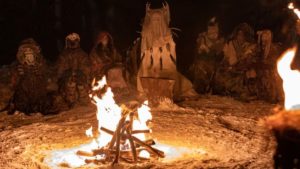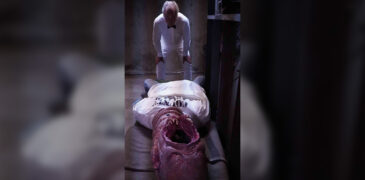
Warning: This article contains mild SPOILERS for season one.
Showtime’s latest series has it all. Teen cannibalism, affairs, corrupt politicians, a haunting soundtrack, and Cristina Ricci.
When Warner Bros. announced plans for a new film adaptation of William Golding’s Lord of the Flies, with the unexpected caveat that it would be about teenage girls rather than boys, many were sceptical that girls would retreat into the same savagery as boys if left to their own devices. Ashley Lyle, who is the co-creator of Yellowjackets, perused comments on the original announcements, and was unsettled by those who were misogynistically dismissive.
According to the New York Times, “Lyle recalled one man’s comment, which read, ‘What are they going to do? Collaborate to death?’ And she recalled what she immediately thought in response: ‘You were never a teenage girl, sir.'” She goes on recount that one girl poisoned another in her high school, how she formed the most intense bonds of her life, and how ferocious her peers often were. She states that she wanted to tell a very real story of teenage girls, of an all-female society, and to do so in a survival setting. The result of this thought process was Yellowjackets (which is unrelated to the original Warner Brothers announcement).

For those unfamiliar with the novel, Lord of the Flies tells the story of a group of adolescent boys who are stranded on an island. At first, they attempt to maintain civility and govern themselves, but one boy breaks off and establishes his own society, which eventually devolves into inhumanity and murder. One by one, the other boys defect from civilization into the savage camp, and by the time the boys are rescued, their humanity is completely erased. The novel ends with the boys being rescued by a military ship. An officer reflects that he can’t believe British boys could be so inhumane, implying that those savage boys will grow up to be equally savage adults, in a manner that is more socially acceptable.
Yellowjackets tells the story is of a high school girls’ eponymous soccer team, which crashes in the wilderness on its way to a national competition in 1996. This is juxtaposed with those who survived as adults in the present day, and the series switches back and forth between the two. In the first episode, it’s revealed that some of them engaged in barbaric acts of trapping the others, murdering them, and eating them in some sort of bizarre ritualism. However, the details of exactly what happened and how it came to be, are some of the main mysteries of the series. Furthermore, with the exception of Misty (Cristina Ricci), their identities are obscured, so who is killed and who did the killing is also a main focus of mystery.

In addition to being influenced by Golding’s novel, the series also draws upon real-life examples of stranded persons resorting to cannibalism, such as the soccer team that crashed in the Andes and the Donner Party. However, all reports and evidence indicate that those in these real-life examples were forced into cannibalism out of survival, whereas in Yellowjackets, the girls begin to harm one another out of spite. From the beginning, it is clear that there are resentments and jealousies bubbling just below the surface, and Lyle expertly crafts how these resentments slowly grow and eventually explode. The story is told in a non-linear manner, split between their relationships before the crash, their time in the wilderness, and present day.
In the present day, it’s been 25 years since the crash. We are introduced to adult survivors Taissa, Shauna, Natalie, and Misty. Taissa is running for public office and has a wife and son. Shauna is married to former best friend Jackie’s boyfriend (Jackie did not survive the wilderness, though we aren’t told the details of her death), with a teenage daughter. Natalie has battled addiction for years and is being released from her latest stint in rehab, where she states that her new purpose in life is going to be to “get even”. Misty is a nurse who engages in sadistic acts of torture against her clients when she perceives any disrespect. The four are forced to re-connect when an unknown blackmailer says they will release the details of “what really happened out there” unless they pay a large sum of money.

In the 1990s, Shauna is jealous of her best friend Jackie, who is just slightly more popular, more of a leader, and more coveted by boys. Taissa is afraid that weak players will hurt their chances of winning, and it’s implied that she intentionally cripples a new team recruit for this reason. Natalie is being abused at home and is unnerved by the things she’ll do to keep her family safe from their patriarch, as well as to seek revenge. Misty is not one of the players and is merely an assistant to the team. She doesn’t feel needed, and the team members often poke fun at her. She is already committing sociopathic acts on small animals.
Like the novel by Golding, it is shown how the seeds planted in adolescence are carried on into adulthood. As the season goes on, we see each teen character slowly lose their grip on civilization in their own way, and engage in more and more savage acts, juxtaposed by their adult counterparts’ facades of normalcy crumbling behind the scenes.

Lyle stated in interviews that girls have a special way of cutting each other down, and this is demonstrated through both the wilderness and the normal world. At one point, Shauna’s teenage daughter, Callie, puts on Yellowjackets’ uniform, thinking it’s her mom’s, when it actually belonged to Jackie. This seems to imply that Callie is carrying on a generational pattern of brutality, that she will invariably act like Shauna did as a teenager and grow up to be her as well. In fact, it’s Shauna’s casual brutality towards her teen daughter that is one of the most unsettling parts of the season.
The thematic takeaway is that adolescence is brutal, but that those brutal girls will grow up to be brutal adults, in a slightly more hidden manner – and that those petty jealousies and social hierarchies have just anthropologically evolved. When we were cave people, those hierarchies may have involved actual violence, but on the soccer field, they may be more cutting remarks or deathly glares. In this series, we are shown what would really happen if modern teenage girls were suddenly thrust back into being cavepeople. We are also forced to confront the way these characters are simultaneously sympathetic and, in many ways, completely sociopathic. We aren’t sure if they are heroes or villains, or if people in the real world can ever be reduced to this binary categorization. While this was an immense, incomprehensible trauma, there also seems to be a perverse pleasure in it (with the exception of Nat, who is drinking and drugging herself to death).
However, the younger counterparts and supporting cast are also formidable talents, and each add another layer to the puzzle — no character or actor is wasted. The journalist who is captured by Misty, remaining totally calm and even humorous, the man with whom Shauna has an affair, the young Lottie slowly descending into madness, the young Laura Lee who stays true to her faith and her desire to save them all.

The series is also expertly edited – cut between the different time periods, with a haunting soundtrack, including an intensely creepy and emotional original score and added songs that create atmosphere, and shots that make the audience unsure what’s real and what’s imagined. In the opening sequence, the school principal states that any girls going missing wouldn’t have been as large a tragedy, but that those girls, “Those girls? Those girls were special. They were champions,” and it immediately cuts to shots of each of them running in slow motion, full of strength and determination.
The cinematography cuts between close shots of things we’d prefer to look away from, such as graphic violence and things we aren’t sure are real, such as Lottie’s hallucinations and Taissa’s sleep-eating dirt. We also see the characters’ subtext such as Jackie’s face as she gazes out onto the horizon. When Shauna slices up a rabbit she found in the garden, the camera cuts between the brutal carving of the rabbit and Shauna’s face, which looks both angry and isolated. There are shots that zoom in from the wilderness at lightning speed, creating a genuinely frightening atmosphere. Is this danger the girls themselves, or something beyond their power to control? While there isn’t actually a supernatural presence (which the audience knows but seriously questions in this moment), there is still a power beyond them – the anthropological norms driving them, and the quest for survival, which is slowly becoming more dire as the food dwindles.
Yellowjackets is expertly written and directed. The execution is inspired by both fictional and factual events, and the casting is masterful as well. In the result of phenomenal acting and cinematography, these produce a series that is both enjoyably scary and highly addictive. Yellowjackets, just one season in, easily stands out as one of the best series of 2021.

Yellowjackets season one is currently streaming on Showtime.
More Reviews
Self-described as a metalhead for life, Chilean filmmaker Patricio Valladares makes some noise in this year’s version of Unnamed Footage Festival. Taking place in San Francisco, this event is proud… Dirty Cop No Donut is a 1999 faux-shockumentary, written and directed by Tim Ritter. Mostly known for creating low-budget gore films, Tim is mostly known as the writer and director… In a previous article of mine, I mentioned the creation of found footage and incorrectly attributed this title to Eduardo Sánchez and Daniel Myrick’s The Blair Witch Project (1999). Although… Two of the things I liked about You’re Next (directed by Adam Wingard, written by Simon Barrett) is a crafty and feisty final girl and a quick-witted script. With Seance,… Unspeakable: Beyond the Wall of Sleep is a 2024 horror film, written and Directed by Chad Ferrin. The film is an adaptation of H.P. Lovecraft’s short story Beyond The Wall… “When six young strangers are invited to a once-in-a-lifetime opportunity – an exclusive dinner party hosted by a charming and enigmatic host on the most romantic night of the year,…Invoking Yell (2023) Film Review- Not with a Bang but with a Shriek (Unnamed Footage Festival 666)
Dirty Cop No Donut (1999) Film Review – ACAB
The McPherson Tape (1989) Film Review – Guess Who’s Coming To Dinner
Seance (2021) Film Review – A Giallo Flick Married To a Teen Slasher
Unspeakable: Beyond the Wall of Sleep (2024) Film Review – An Inventive Yet Deferential Reimagining
Most Horrible Things (2022) Film Review – Most Horrible Indeed!
Voting member of the Independent Spirit Awards. Charter subscriber to the Criterion Channel. Silent and pre-code horror enthusiast. In my “real” life, I’m a human rights activist, social scientist, and burlesque performer





